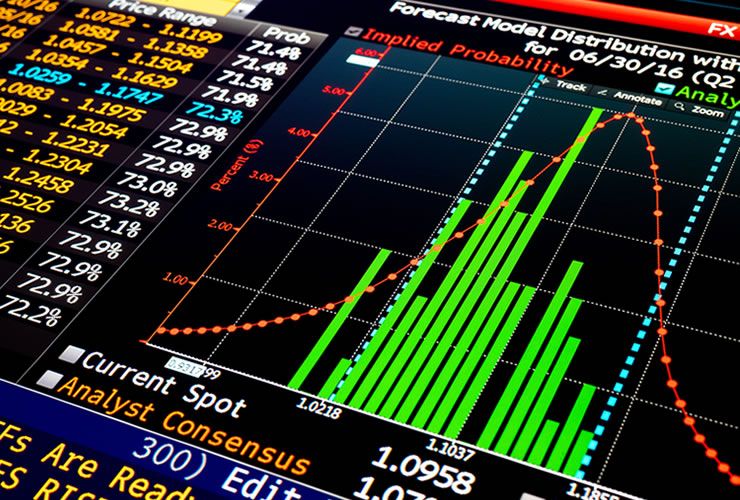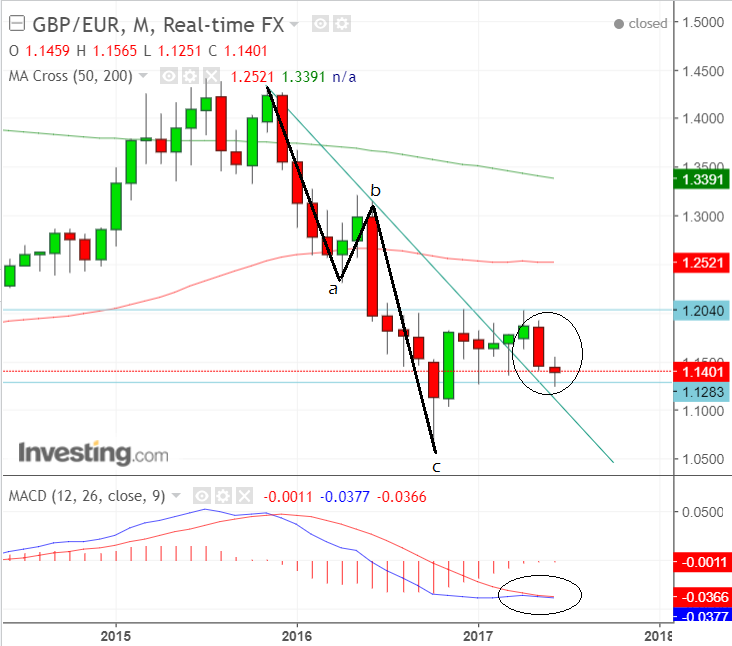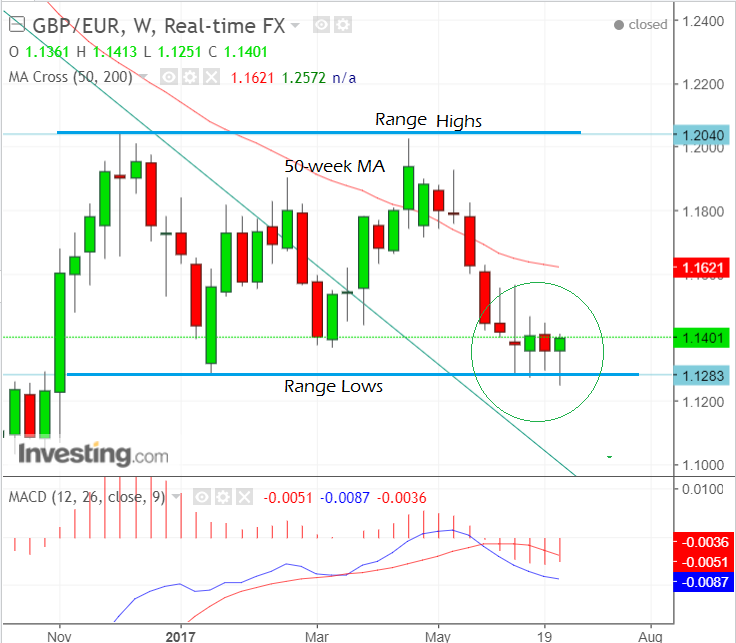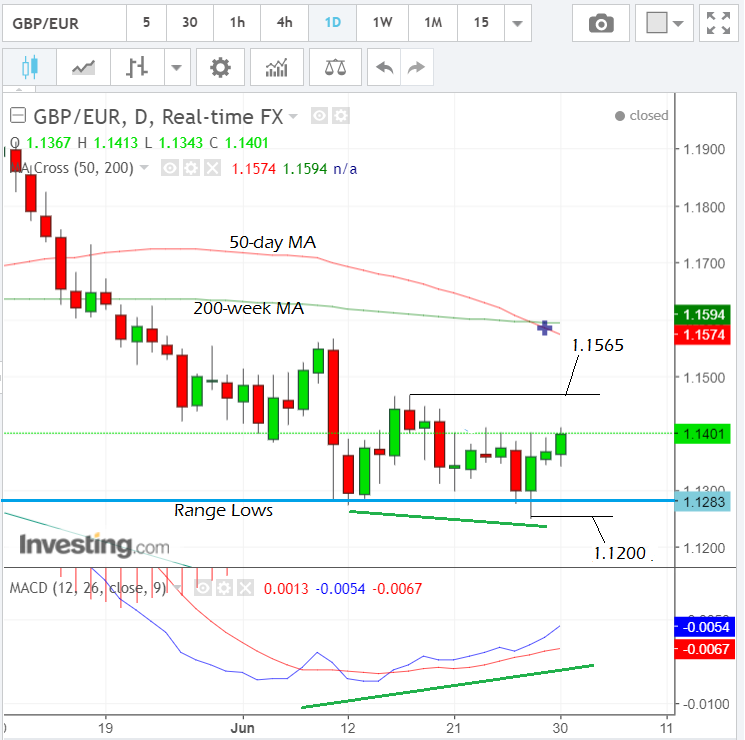Forecasts Show GBP/EUR Exchange Rate Bullish (But Still Within a Well-Traded Zone)

- Spot Market Quotes:
- Pound to Euro Rate Today: 1 GBP = 1.1395 EUR, day's best: 1.1420, low: 1.1381
- Euro to Pound Sterling Rate Today: 1 EUR = 08773 GBP, day's best: 0.8786, low: 0.8756
GBP/EUR has been trading a narrow range inside the 1.1300-1.1500 zone for several weeks now and it would appear no major breakout is nigh. Therefore we are left trying to trace a path forward within a relatively well-travelled zone.
The weekly chart confirms that since the start of the year the exchange rate has traded within the 1.1300 and 1.2000 area.
Longer-term technical signs are bullish for GBP/EUR and suggest it may start to move back up towards the 1.2000 range highs.
But, fundamentally the Euro looks more stable given the relaxation of political risk since Macron’s victory over Le Pen in France.
A possible heat spot in the map of next week could be on Monday and Wednesday mornings when the two region’s PMI’s are released within 30mins of each other, lending themselves to an immediate comparison.
Research shows that if one country’s/region’s PMI rises and the other falls – or vice versa – GBP/EUR can generate a fairly strong move in response.
The Monthly Chart: Long-Term Clues
Panning out and we see the monthly chart - i.e longer-term timeframe that should see us through the remainder of the year - we see some noteworthy features.
On the monthly chart GBP/EUR is showing bullish reversal signs despite still being in a downtrend on lower timeframes.

The last two down-months representing May and June - occurring as they did within an up-move from the October 2016 lows - were probably corrective in nature and suggest July will be an up-month.
Research has proven that when two down-months happen together within an up-move or trend, they normally represent a correction of the main trend, which reverses in the next month.
The set-up accurately predicts that the next month will be bullish to a 66% degree of probability.
There is, therefore, a higher than evens probability that we are beginning a bullish month for Sterling against the Euro.
Also looking at the monthly chart, we note how the exchange rate finished a clear a-b-c move, also known as a measured move, when it formed the October 2016 lows.
The pattern is clearly delineated and waves ‘a’ and ‘c’ are of roughly equal length.
When an a-b-c pattern finishes it is often a sign a change of trend will occur afterwards, which further adds evidence that we are at the start of a new uptrend for the pair, and lends weight to the idea that July will be bullish.
The MACD looks like it is basing and is likely to rise, further adding to the evidence indicatin the potential for more upside.
Weekly Chart: Medium-Term Clues
The weekly chart is showing GBP/EUR is now at the base of a very clear range which has been forming during 2017, whose lows are at 1.1300 and highs at 1.2000.

It has posted several bullish hammer-like reversal candles in a row (circled), which suggest the potential for a reversal back up to towards the range highs.
The other main feature of the chart is the 50-week moving average at 1.1621 which is likely to exert a downwards pressure on the exchange rate when it comes close to it.
Moving average are not just indicators of long-term equilibria, but also levels where traders often make counter-trend trades and therefore where trends are at risk of stalling or even reversing.
Any gains, we, therefore, see encountering resistance in the 1.1620 area.
Daily Chart: Near-Term Clues
Drilling down to the daily chart gives us a more detailed view of the range lows.
It shows how GBP/EUR has continued to make lower lows and has attempted to pierce below the key 1.1300 range lows in the previous week.
The three most recent days have all been up-days, which is an encouraging sign for bulls, but until we get a clearer break above a key level the short-term trend technically remains down.
The convergence between bullish looking MACD indicator which is rising and price which is moving lower, indicates bullishness.
Only a break above the 1.1469 highs would reassure us that a new up-trend was beginning.
Such a move would at first target 1.1565 where the 50-day moving average is situated.
There is still a chance, however, that until that happens GBP/EUR could extend its downtrend lower, piercing the range floor and then breaking out sharply lower.
Such a move, though less likely in our view, cannot be discounted.
The 50-day moving average, for example, has just completed a bearish ‘Death Cross’ by moving below the 200-day.
Confirmation would come from a break below the 1.1251 lows and would reach an initial target at 1.1200, but then would probably move down to at the very least 1.1000.
Breakouts from ranges often go as far as the height of the range extrapolated lower or at least 61.8% of the height.
Given the height of the range is 700 points this would indicate that to suggest a target below-1.1000 would not be to over-exaggerate.

Data, Events to Watch for the Pound
The next week is dominated by PMI survey data for June, which shows monthly changes in activity in key sectors of the economy.
PMI’s are plotted on a gauge, with a result below 50 representing contraction and above 50 expansion.
On Monday at 9.30 BST Manufacturing PMI is released and is expected to tick down to 56.5 from 56.7.
On Tuesday at the same time Construction PMI is forecast to fall to 55.00 from 56.00.
Finally, on Wednesday the most important PMI for the Services sector is forecast to show a fall to 53.5 from 53.8.
The results will be analysed within the context of ongoing concerns about growth given the sharp slowdown which has occurred on the high-street and the fall in real wages.
Investment bank TD Securities see a chance of an even deeper undershoot than consensus, with Manufacturing falling to 55.7 rather than 56.5 and Services to 52.8 rather than 53.5.
“Given the political uncertainty that came out of the general election, we look for a decline in the June PMIs, though much more moderate than the post-Brexit shock last year. We saw the first hint of that kind of reaction with the GfK consumer confidence survey, which saw a fairly sharp decline in June.”
Clearly a surprisingly weak figure will hurt sterling.
Other data includes Manufacturing and Industrial Production, the NIESR GDP Estimate and Halifax House Prices, all out on Friday at 09.30 BST.
Data, Events to Watch for the Euro
The main release for the Euro are the minutes from the European Central Bank (ECB) meeting in June, out on Thursday, July 6 at 12.30 BST.
There will be much focus on the extent to which the governing council discussed winding down – or ‘tapering’ as it is known – monetary stimulus.
ECB president Draghi let the genie out of the bottle last Tuesday at the central banking conference in Sintra, when he suggested stimulus didn’t need to be as substantial as it had been going forward, and now we shall see how representative these comments were of the whole council.
Outright discussions of tapering are not likely and so moves in the Euro may be muted following the minutes’ release.
“Draghi said though that the ECB did not discuss tapering at this meeting, so markets probably won’t get more insight into what they really want to know heading into the autumn and the expected 2018 tapering decision,” said TD Securities.
Other major events include the Bundesbank President Wiedmann’s comments today.
Weidmann is against stimulus and so is expected to continue to argue for a reduction as soon as possible.
Eurozone Manufacturing PMI is out on Monday morning at 09.00 BST and is likely to remain unchanged at 57.3 in June.
Services PMI is out at the same time on Wednesday and is also expected to stay unchanged at 54.7.
Eurozone unemployment in May is out on Monday at 10.00 and is forecast to show a further reduction to 9.2% from 9.3% previously.
Eurozone Retail Sales in May is out on Wednesday morning at 10.00 and is forecast to rise by 0.3% from 0.1% in April.
Overall if investors see a continuation of the slow and steady growth trajectory they will continue to invest in the region, leading to an appreciation of the Euro.





